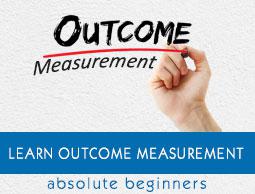Outcome Measurement - Introduction
As per the data shared by the American Society for Training & Development (ASTD), the companies in the US provide a minimum of 30 hours of training to their employees, which costs them roughly 40 dollars for each hour of employee training. The companies in the US alone end up spending a minimum of 165 billion dollars on providing various kinds of training. Can we prove whether any genuine learning has taken place from all this training? With such huge amounts of money being poured into this sector, it’s a question we no longer can afford to ignore.
In an economy where 17% of the population earns below 1000 dollars annually (counting students and undergrads), a training expense of around 1200 dollars per employee annually as training expenditures is a proper Comparison Chart to understand the investment organizations do in this sector. These numbers make it sufficiently clear that the companies, big or small, do invest large sums of money into training their employees. The issue crops up when we try to organize numbers for the other side of the spectrum, which make it difficult to give solid facts to prove whether any genuine learning has taken place.

What is Outcome Measurement?
There are countless ways in which the word outcome can be interpreted but it’s commonly agreed that Outcome Measurement is the act of assessing the impacts of a decision and check its impact.
Outcome measurement is a systematic method of observation and calculation to determine the success of a training program. The chief areas that it takes notes on are −
Has this program brought any difference to the behavior of the employee?
How are the performances of the employees better after the program?
What changes the program brought in the lives of employees, their families, and the organization?
Although there are many uses for the information generated by outcome measurement, managers often choose to ignore it because they don’t understand the holistic method to approach this process. They need to understand that the act of delivering training is just the means to an end, and not the end deliverable in itself.
The days of evaluating employees and their skill-sets based on tests with multiple-choice questions has now been discarded as a defective method. Such assessments can be easily cleared by employees using short-term retention of knowledge. The new-age testing methodologies require that employees cultivate a long-term ability to apply the knowledge they have gained from their training. The goal of the employers is to see a healthy Return on Investment on their training, which means a significant growth in the performance levels of the people.
Outcome Measurement is NOT Performance Measurement
During the last thirty years or so, most of the organizations were happy focusing on what their employees did, what staff they had, how many hours of work did they put in, which department to recruit more resources for, etc. And that was it.
What has changed now is the implementation of Outcome Measurement, which attempts to make a question out of the statements on performances mentioned above in the following manner −
Does the performance of the employees increase if they are given ten hours of technical assistance on job-related techniques? Is the organization able to save more time in doing the same work?
Does a strategic planning process help the organization save efforts and resources on getting the same workload done? If so, then is the benefit worth investing on in the long run?
Outcome Measurement is mostly mistaken with Performance Measurement. There is a difference in both: Performance Measurement is mostly used in business and profit-making ventures; whereas Outcome Measurement is used in non-profit organizations, where the stress is more on output, rather than revenue generation.
Measuring Training Outcomes
Can we pull out training measurement data, similar to the numbers invested in the training, and say the amount of improvement that employees have brought in their performances because of the training imparted to them?
Measuring training outcomes is fast becoming one of the most widely growing research areas in the world of business. Most organizations implement Outcome Measurement because they are asked to do so by the higher management.

In today’s competitive world, organizations are more interested in hiring employees who can deliver outcomes on the ground, rather than people who are termed good performers because they cleared some test. The doers are valued much higher than theoretical winners; business has become more result-oriented than ever.
Managers who don’t believe in measuring the output of training neglect one of the most important and fundamental functions in Business Administration, and become isolated from the many positives of generating Result Measurement Reports for the profitable functions of the organization. They need to know in periodic intervals if the education they are paying for to improve their employees’ skill-sets are bearing any fruit. The necessity to employ winners makes organizations hungry for outcomes.




